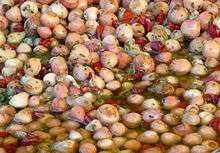Leopoldia comosa
Leopoldia comosa (syn. Muscari comosum) is a perennial bulbous plant. Usually called the tassel hyacinth[2] or tassel grape hyacinth,[3] it is one of a number of species and genera also known as grape hyacinths. It is found in rocky ground and cultivated areas, such as cornfields and vineyards,[4] in south-east Europe to Turkey and Iran,[5] but has naturalized elsewhere. In southern Italy and Greece, its bulb is a culinary delicacy.
| Leopoldia comosa | |
|---|---|
| Scientific classification | |
| Kingdom: | Plantae |
| Clade: | Tracheophytes |
| Clade: | Angiosperms |
| Clade: | Monocots |
| Order: | Asparagales |
| Family: | Asparagaceae |
| Subfamily: | Scilloideae |
| Genus: | Leopoldia |
| Species: | L. comosa |
| Binomial name | |
| Leopoldia comosa (L.) Parl.[1] | |
| Synonyms[1] | |
| |
Description
Described by Oleg Polunin as "a striking plant", it has a tuft of bright blue to violet-blue sterile flowers above brownish-green fertile flowers, which open from dark blue buds,[4] reminiscent of a menorah candelabrum. This tuft gives rise to the name "tassel hyacinth".[5] The flower stem is 20–60 cm tall; individual flowers are borne on long stalks, purple in the case of the sterile upper flowers. Mature fertile flowers are 5–10 mm long with stalks of this length or more and are bell-shaped, opening at the mouth, where there are paler lobes. The linear leaves are 5–15 mm wide, with a central channel.[4][5]
Leopoldia comosa naturalizes easily and may become invasive. It has spread northwards from its original distribution, for example appearing in the British Isles in the 16th century.
In a cultivar called 'Monstrosum' or 'Plumosum', all the flowers have become branched purple stems.[5]
Cuisine
During Roman times, Pliny noted that the bulbs were eaten with vinegar, oil, and garum.[6] Today, it is still eaten in some Mediterranean countries. In Apulia and Basilicata, it is cultivated and known as lampagioni or lampascioni.[7] In Greek it is called βολβοί, βροβιοί volví, vrovií (ασκουρδαλάκοι in Crete). In Greece and especially on Crete, it is considered a delicacy and collected in the wild. The cleaned bulbs are boiled several times, pickled, and then kept in olive oil.
Gallery
 Lampascioni sott'olio, made from bulbs of Leopoldia comosa, is a gastronomic specialty of the Italian region of Apulia
Lampascioni sott'olio, made from bulbs of Leopoldia comosa, is a gastronomic specialty of the Italian region of Apulia Leaves of the plant
Leaves of the plant Illustration from Johann Georg Sturm (Painter: Jacob Sturm) 1796. Deutschlands Flora in Abbildungen, plate 40.
Illustration from Johann Georg Sturm (Painter: Jacob Sturm) 1796. Deutschlands Flora in Abbildungen, plate 40.- Ornamental cultivar 'Plumosum'
 Clear flower view, Djerba island, Tunisia
Clear flower view, Djerba island, Tunisia
References
- WCSP (2011), World Checklist of Selected Plant Families, The Board of Trustees of the Royal Botanic Gardens, Kew, retrieved 2011-11-14, search for "Leopoldia comosa"
- "BSBI List 2007". Botanical Society of Britain and Ireland. Archived from the original (xls) on 2015-01-25. Retrieved 2014-10-17.
- "Muscari comosum". Natural Resources Conservation Service PLANTS Database. USDA. Retrieved 28 January 2016.
- Polunin, Oleg (1969), Flowers of Europe : a field guide, London: Oxford University Press, ISBN 978-0-19-217621-9, p. 502 (under the name M. comosum)
- Mathew, Brian (1987), The Smaller Bulbs, London: B.T. Batsford, ISBN 978-0-7134-4922-8, p. 130 (under the name M. comosum)
- Pieroni, Andrea (2005). Prance, Ghillean; Nesbitt, Mark (eds.). The Cultural History of Plants. Routledge. p. 39. ISBN 0415927463.
- "Lampascioni Proprietà Controindicazioni Ricette Foto e Riflessioni". Lampascione.it. Retrieved 2018-10-09.
External links
- Wild Flowers of the British Isles: M comosum
- Paghat's Garden: M comosum
- Paghat's garden: M comosum 'Plumosum'